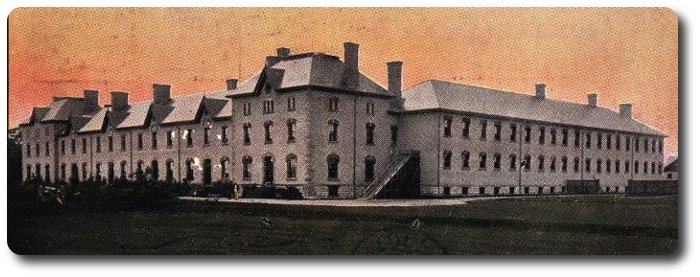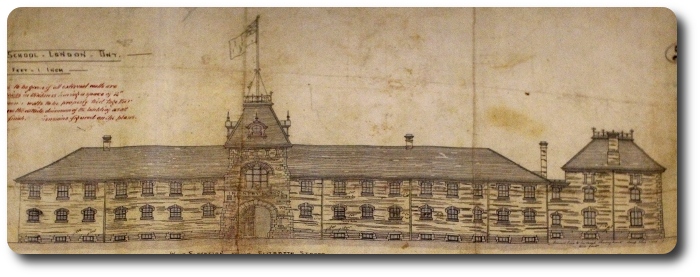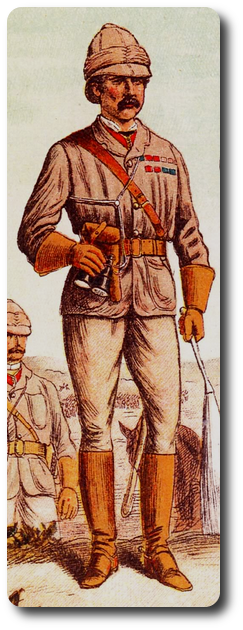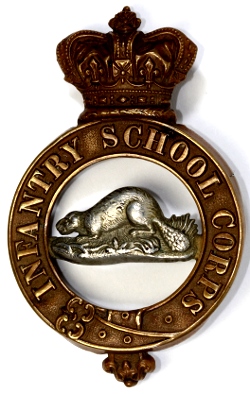Topic: Wolseley Barracks

The Old Barracks
Off Parade; newsletter of No. 1 District Depot, Wolseley Barracks, July 1946
By: Colonel Francis B. Ware, D.S.O., V.D.
For more than two decades following the Rebellion of 1837, London was garrisoned by famous British regiments, and many are the stories told of the gay life of the young city, as its charming debutantes flirted, danced and married the dashing young soldiers of the Queen.
In those far-off days of a century ago, Victoria Park, Wellington Street to waterloo and Piccadilly south to Dufferin Avenue was all Government property, reserved for barracks, ordnance and supply depots and parade grounds, while there may be some who still remember the depression where the C.P.R. station and freights sheds now stand, for there the Royal Engineers created Lake Horne, as shown on the early maps of London, where in the summertime the troops enjoyed, with their civilian friends, boating, swimming, and aquatic sports.
And then with the withdrawal of the Imperial garrisons and the gradual transfer of the army property to the Corporation of London and to individuals for park and residential purposes, the Government purchased the old Carling farm and the south-east corner of Oxford and Adelaide Streets and there, for over three-quarters of a century, the Cavalry, Artillery and Infantry regiments of the district have carried out their annual training.
The increasing interest being shown in the various volunteer units of the district, and the activity accentuated by the departure in April, 1885, of the Seventh Fusiliers to the Canadian North-West to help quell the Riel Rebellion was no doubt a contributing factor in the decision that London, the capital of the prosperous and growing counties of south-western Ontario, was the logical spot for the establishment of the new military school, to be built on Carling Heights at the north-west corner of the farm.

The first sod was turned and the great building started on the 5th May, 1886. Two million bricks were made by the old London firm of Walker, Bros., for the general contractors, Messrs. Hook & Toll and, on Dominion Day, the 1st of July, the foundations were in and all was in readiness for the ceremony of the laying of the cornerstone.
It was a gala day in London, with the camp in full operation, and over 5,000 visitors thronged the streets of the young city.
Sir Adolphe Caron, the Minister of Militia, had come from Ottawa to officially lay the stone, the distinguished visitor and the senior officers attending camp were tendered a banquet at the City Hall and, at its close, the troops which had been on the route march escorted Sir Adolphe and his party, which included Sir John Carling, Mr. A. McKenzie, M.P.P., and Mr. W.R. Meredith, M.P.P., to the decorated platform on the Heights, where Mayor Hodgins read the address of welcome.
With the stone well and truly laid, the official party and the thousands of visitors witnessed a stirring Review of the three thousand men attending camp, and then came one of those old-fashioned sham fights with the opposing forces fighting in plain view of each other.
The plans of the building proved the architect of the day to be one of vision. The frontal section, which commanded a fine view of the camp and the city to the south-west, provided quarters for the Commandant, senior and junior officers, mess and lecture rooms and offices. The east wing contained the N.C.O.'s married quarters, men's dormitories and mess rooms, band and store rooms; while the west wing had married quarters, Sergeants' mess, guard rooms and the station hospital.
 In 1867, there came to Canada, as the senior Staff Officer, a brilliant young soldier who, though but 34 years of age, had already seen service in the Crimea, at the Relief of Lucknow and in China, and who, in 1870, was chosen by Ottawa to command the Red River Expedition to the then almost unknown Canadian West, where the rebel Louis Riel headed an uprising to establish a Republic of North-West Canada.
In 1867, there came to Canada, as the senior Staff Officer, a brilliant young soldier who, though but 34 years of age, had already seen service in the Crimea, at the Relief of Lucknow and in China, and who, in 1870, was chosen by Ottawa to command the Red River Expedition to the then almost unknown Canadian West, where the rebel Louis Riel headed an uprising to establish a Republic of North-West Canada.
After incredible hardships and difficulties encountered in moving the Force from the head of Lake Superior to the rebel station at Fort Garry (Winnipeg) the uprising was subdued, and a garrison left to prevent further trouble.
In 1882, as a reward for his distinguished service, this young officer was promoted to the rank of General, and raised to the Peerage with the title Baron Wolseley of Cairo and Wolseley.
It was, therefore, most fitting that Ottawa should decide to call the new Military School "Wolseley Barracks," in recognition of the great service which that gallant officer had rendered to Canada during his tour of duty here.
 The School was formerly opened on the 31st March, 1888, with Colonel Henry Smith, a veteran of the North-West Rebellion of 1885, as Commandant, and the barracks became headquarters of "D" Company, Royal Infantry (sic). The establishment of the School was six Officers and one hundred N.C.O.'s and men, many of whom were recruited locally; and then started the first courses of instruction.
The School was formerly opened on the 31st March, 1888, with Colonel Henry Smith, a veteran of the North-West Rebellion of 1885, as Commandant, and the barracks became headquarters of "D" Company, Royal Infantry (sic). The establishment of the School was six Officers and one hundred N.C.O.'s and men, many of whom were recruited locally; and then started the first courses of instruction.
Space will not permit me to dwell on the glories of the old barracks, which today stand strong, barely showing effects of the sixty years that have passed since the cornerstone was laid, but what a multitude of pictures pass in review before memory's eye — The Royal Canadian Regiment and the Princess Patricia's Canadian Light Infantry; the courses attended by officers and N.C.O.'s from all over Canada, many of whom distinguished themselves on the field of battle; the Permanent Force officers of other days, Smith, Dennison, Peters, Young, MacDougall, Hodgins, Shannon, MacDonnell, Carpenter, Gibsone, Uniacke, Eaton, Hill, Hemming, Balders and others; the brilliant dress uniforms of the officers, their dog-carts and horses; the band concerts on the terrace, and the drums on the Square; the stately mess dinners and receptions to Governor-generals, and other eminent Empire citizens; and through the years the thousands of men as the marched away through the arcade to fight for Queen or King and country.
But now the scene is changed: battle dress is the order of the day. No longer are the men going away to war but, instead, the Barrack Square rings to the tramp of returning heroes.
The old motto was "In time of peace, prepare for war," and so will Wolseley Barracks continue to train our young Canadian in the defence of our fair Dominion and those freedoms for which the whole Allied world has fought and must continue to guard.

